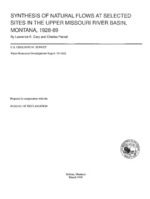Natural monthly streamflows were synthesized for the years 1928-89 for 43 sites in the upper Missouri River Basin upstream from Fort Peck Lake in Montana. The sites are represented as nodes in a streamflow accounting model being developed by the Bureau of Reclamation. Recorded and historical flows at most sites have been affected by human activities including reservoir storage, diversions for irrigation, and municipal use. Natural flows at the sites were synthesized by eliminating the effects of these activities. Recorded data at some sites do not include the entire study period. The missing flows at these sites were estimated using a statistical procedure. The methods of synthesis varied, depending on upstream activities and information available. Recorded flows were transferred to nodes that did not have streamflow-gaging stations from the nearest station with a sufficient length of record. The flows at one node were computed as the sum of flows from three upstream tributaries. Monthly changes in reservoir storage were computed from monthend contents. The changes in storage were corrected for the effects of evaporation and precipitation using pan-evaporation and precipitation data from climate stations. Irrigation depletions and consumptive use by the three largest municipalities were computed. Synthesized natural flow at most nodes was computed by adding algebraically the upstream depletions and changes in reservoir storage to recorded or historical flow at the nodes.


